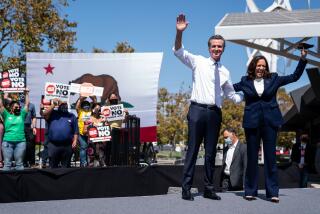Convention dissension
- Share via
Two ballot initiatives were filed last week that, if passed, would call forth a constitutional convention in California. Half of the approximately 435 delegates would be randomly selected, the other half appointed by local officials to represent citizen diversity. Those in favor of rewriting the state Constitution through a convention are encouraged by a growing acceptance that the current document is an unworkable hodgepodge of conflicting amendments, largely culpable for our broken legislative process. Unfortunately, they cannot escape a simple political fact: Legitimacy demands a diverse convention; yet the more diverse it is, the more partisan it will be, and the more partisan, the less likely it is to succeed.
Californians should not mistake a widely shared dislike of our political situation with shared agreement on what constitutes the common good. An improved Constitution requires a greater unity and sense of common purpose than we are likely to see any time soon. The call for a convention stems from a recognition, and dislike, of our internal discord -- that is, from our competing interests. A convention, rather than smoothing over our divisions in an effort to produce a workable document, is likely to exacerbate them.
A convention could produce “a document in which competing interests are balanced,” in the sunny opinion of this newspaper’s editorial board. The public square could be cleared of “vicious partisan warfare,” opening a space for the give-and-take of healthy “conversation” over the future form of government. A measure of this potential is supposedly already seen in the bipartisanship of the calls for a convention.
That view downplays the fact that there are two prominent, divergent and competing stories of how California arrived at this point. In the first, the late-1970s tax revolt was a smashing success at both lowering taxes and dampening big government until it was effectively nullified by various countermeasures -- notably Proposition 98, a confusing 1988 initiative backed by the teachers unions that mandated high levels of state education spending. In the second, the tax revolt and the two-thirds legislative requirements for raising taxes and passing the budget created an ungovernable situation in which the will of the majority is stymied by an anti-government fringe.
What is required to succeed at writing a good constitution? James Madison warned of the difficulty in reproducing the founding era’s achievement. In the Federalist Papers, he credited the extraordinary circumstances of the revolutionary period. Not hyperbolic talk of vicious partisan battles but actual, brutal assaults of an imperial army fostered a cooperative spirit that forced the founders to overcome differences.
We can easily judge whether anything even approaching the circumstances Madison outlined exist in California: Are those pushing for reform moved more by passion or by cool deliberation? Do we have such confidence in our leaders and representatives -- in any who would draw up a new constitution -- that the ordinary diversity of our opinions can be laid aside? Are the changes to be made, or the abuses to be reformed, unconnected to the spirit of prominent interests?
Madison held that it is reason, not the passions of the people, that ought to rule, so he recommended great caution when approaching the reopening of constitutional questions. We are both blessed and cursed in California with an in-between system that, while avoiding the wholesale tumult of a convention, allows for limited, single-subject amendments by initiative. Rather than the constant trickle of public passion encouraged by this process, it is tempting to establish a forum for wholesale change in order to end what The Times called our “virtual convention” of the last three decades.
But the temptation of a convention hides its weaknesses. There is a deep-felt need for change in California. Creating a “unified executive” (in which the governor rather than the voters chooses and so is responsible for such officials as the lieutenant governor) and reforming the way the initiative process allows for “ballot-box budgeting” are just two ideas that might improve governance in the Golden State. But these are specifics best hammered out in a forum that tolerates -- even demands -- bickering, division and the partisanship that is the normal outgrowth of republican-style democracy. A constitutional convention is too broad and big an approach for such tasks -- it requires too much unanimity. It will either break apart in partisanship or create a false consensus around a flaccid document.
For Madison, the necessary precondition of a successful convention was the unnatural suppression of dissent. Those in favor of a California constitutional convention believe that it can be limited to the big issues and that the necessary common ground will be found in the process. But regardless of the form the convention takes, our current divisions -- those very divisions that lead us to identify the present mess, as well as blame the other side for getting us into it -- will remain part of the debate. The very diversity we need to give the proceedings legitimacy all but guarantees dissent. The question of how best to reform government will not be decided on the true merits of the case at such a gathering but will be a repetition, and telescoping, of our current partisan bickering.
More to Read
Get the L.A. Times Politics newsletter
Deeply reported insights into legislation, politics and policy from Sacramento, Washington and beyond. In your inbox twice per week.
You may occasionally receive promotional content from the Los Angeles Times.








